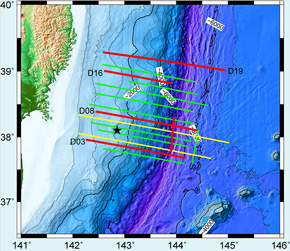Minimizing earthquake and tsunami damage
“The seismological, geological, and ocean science communities have a clear obligation to learn and explain as much as possible about this event,” says Prof. James J. Mori of the Disaster Prevention Research Institute, Kyoto University, one of the co-chief scientists. He also spoke of the determination of the JFAST research team, and said that it is appropriate that an international team of IODP scientists are leading these important efforts. Another of the co-chief scientists Prof. Frederick M. Chester (Dept. of Geology and Geophysics, Texas A&M University), a specialist in structural geology, says: “As a scientist, I have an obligation and desire to help us learn as much as we can about the origin of great tsunami earthquakes in the hopes of minimizing human suffering and property damage in future events around Japan and throughout the world.”
Some seismologists thought that the region of the plate boundary near the trench axis of the Japan Trench, was not likely to have large slip during major earthquakes. This is because the sediments and fluid content may produce a low strength fault that does not accumulate large amounts of stress. Last year’s earthquake has changed much of that thinking. Prof. Mori stated the importance of the JFAST project: “The slip on the shallow portion of the megathrust is one of the main causes of the large tsunami and is the designated target of the JFAST drilling. A smaller magnitude of earthquake could also generate very large tsunamis, if there is large slip in this region. We anticipate that the results from the JFAST drilling will provide us with a better understanding of the faulting mechanisms for this critical location. ”
Professor Chester also spoke of his pre-departure hopes.
“I acknowledge the importance and difficulty of the Expedition. Through cooperation between ship-board scientists, on-shore advisors, and the ship operators and drilling engineers, I am confident that we can achieve the science goals of the expedition. I believe that the knowledge gained from this expedition will someday help mitigate hazards of future earthquakes and tsunamis.”
Investigating the mechanisms that produce huge earthquakes from the sea floor

Bathymetric map of the seafloor close to the planned drilling site. Lines are the survey lines of the seafloor topographical survey conducted by the JAMSTEC research ship Kairei
In the Tohoku region, the Pacific plate on the east side of the Japan Trench subducts under the overriding North American plate. These plate movements are the main cause of the many major earthquakes that have caused significant damage in the region throughout historical times. During the 2011 earthquake off the Pacific coast of Tohoku, recent results show that, the seafloor of the Japan Trench moved about 50m horizontally and 10m vertically. These large displacements of the sea floor caused the tsunami that caused so much damage along the northeast coast of East Japan.
Ryota Hino is a member of the project management team for this research expedition and studies seafloor earthquakes. Hino is associate professor in the Research Center for the Prediction of Earthquakes and Volcanic Eruptions at the Graduate School of Science, Tohoku University, who studies seafloor earthquakes. Professor Hino has set up seismometers and water pressure gauges on the sea floor off the coast of Miyagi Prefecture for ongoing long-term observations of seismic activity in the area. “When we analyzed the data brought up from the seafloor by the measurement equipment at the end of March 2011, the water pressure gauges set near the Japan Trench showed a change in water depth that suggested substantial upthrust,” Hino says. “Comparisons with data from other water pressure gauges showed that while the earthquake caused a large upthrust in the seafloor close to the trench, locations near the coast had subsided about one meter. With the movement of the overriding plate from this earthquake, it seems likely that the sea water above the plate was pushed up, and that this is what caused the huge tsunami.”
“The properties near the trench are the key to figuring out the mechanism that caused this huge earthquake. Deep exploration of the crust with CHIKYU, unlike sea floor research to date, can drill into the fault directly and make possible to understand the state of faults. There is a good chance that this research will lead to breakthroughs in elucidating the mechanisms that generate earthquakes. Our hope is that the results of work will help to construct a next-generation model of how earthquakes work. We believe that the revised model will be the benefit of our society,” says Professor Hino.
